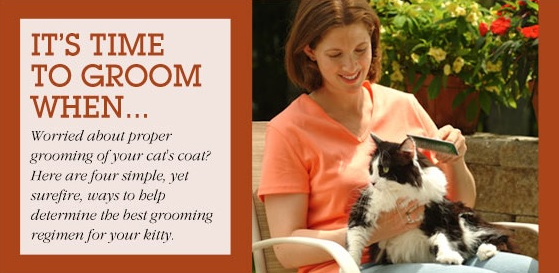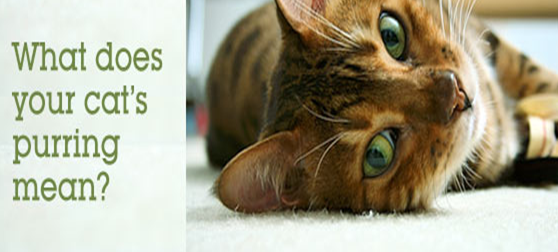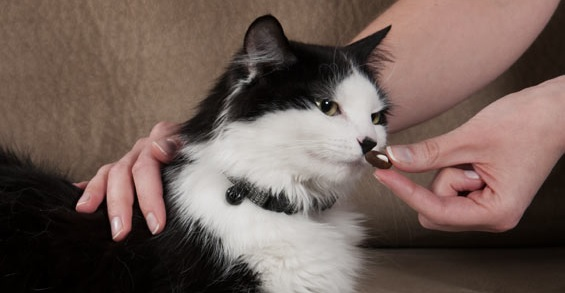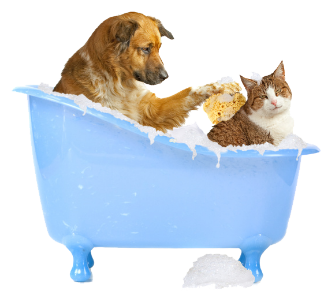
When To Groom Your Cat
Consider the following factors when determining the frequency at which you groom your cat:
The length of your cat's hair
In general, cats with long hair need much more frequent grooming, often on a daily basis. Cats with short hair can be brushed several times a week.
Your cat's ability to groom herself
Cats who are overweight or ill often have less ability or desire to groom themselves. Older cats who may have arthritis may also tend to groom less. These cats should be groomed on a more frequent basis.
The amount your cat is shedding
The amount your cat sheds varies throughout the year. When your cat is shedding less, especially if she's a "shorthair," you may brush or comb your cat and remove very little hair. Other times, it may seem to come out in handfuls. The more a cat is shedding, the more often you should groom her. This will also greatly decrease her risk of developing hairballs.
Your cat's tolerance to grooming
Some cats love to be groomed - giving you excellent "bonding time" and a beautiful cat. Conversely, some cats seem to despise brushes and combs, and should therefore be groomed only on an "as needed" basis.
Why Do Cats Purr?
Contentment, comfort, security... for many pet owners, the humming purr of a squinting cat is the unmistakable signal that their feline is happy and healthy.
|
||||
- In many ways this is true: behaviorists believe the original function of purring was to enable a kitten to tell his mother that "all is well." This often occurs during nursing. A kitten can't meow and nurse at the same time, but can purr and nurse without any problem. The mother often purrs back, reassuring the kitten using this tactile, resonant communication.
This is why your cat purrs when petted, instinctively giving the signal "all is well," a message you can both feel and hear.
But this isn't the only message purring may signal:
- Older cats purr when they play or approach other cats, signaling they are friendly and want to come closer.
- Cats also purr when they are distressed or afraid. Sick and injured cats, and those in veterinary offices often purr. It is thought that this is the cat's way of reassuring and calming herself.
Purring is one of several methods of non-verbal communication felines use to convey their moods and needs. Others include squinting or slow blinking, stretching, scratching, facial rubbing, and spraying. So the next time your cat is purring deeply while curled in your lap, try purring back - she'll know what you're saying!
How Do I Give My Cat A Tablet, Caplet, or Capsule
We know that giving your pet the medications she needs at the right time depends a great deal on how easy it is for you to give this medication to your pet. With this in mind, we have created some simple steps to help you give your pet meds the way the professionals do (and the easiest way possible!).
Since cats are more apt to chew their food than dogs, it is generally more difficult to give a cat a pill than it is a dog. In addition, a cat may bite and learn quickly to avoid the person giving the pill.
Make sure to ask your veterinarian if your cat can take this medication with food, or if your cat has any food restrictions.
5 steps to accustom your cat to getting a pill
Here are some steps to help get your cat accustomed to being handled enough to have medications given to her:
- Call or take her to a favorite place, such as one where you feed her.
- Give her a favorite treat and stroke her so she associates the place with good things.
- As she learns to come to you excitedly, start putting your hand on her jaw and hold it for a short time (release her jaw before she pulls away).
- Once she's comfortable with this step, move on to putting a finger briefly into her mouth, then to opening her mouth.
- Some cats will learn to tolerate this more quickly than others. Learn your cat's tolerance for this.
Obviously, it would be ideal to teach this to your cat before you have to give medication, but it can still be done if you are gentle and patient.
Once your cat is used to being handled this way, or if you have a mellow cat, you can use the following steps to help you give your cat pills:
- If your cat is on dietary restrictions, ask your veterinarian what kind of canned food you can use as a treat or if there is something such as turkey, chicken, or cheese you can use to give her medication. If you give your cat pills in a "treat" form, give her a test-treat first, to ensure that she'll eat it.
- If your cat is not on dietary restrictions, and your veterinarian said the medication can be given with food, the easiest way to give a pill is to hide it in a piece of food. Or, consider Drs. Foster and Smith Pill Ease Treats for Cats, delicious, convenient, hollowed out treats made just for this purpose.
Note: We do not recommend giving meds in your cat's meals, because if she tastes something she doesn't like she may not want to eat any of it and she may become suspicious of future meals. Also, if she does not eat the entire meal, she will not get the appropriate dose of medication.
If your cat will not take the pill in food or cannot have food with the medication, then you must give it by hand. Use the following guide to help you do this:
Give your cat a pill if she won't take it with food
- Get the pill out of the bottle and place it where it will be handy.
- Bring your cat to the place you will give the pill, talking to her in a happy voice. If you do not sound worried or concerned, your cat will be less likely to feel that way as well.
- Sometimes, it is helpful to wrap the cat in a blanket or very large towel so just her head is sticking out. Place her back end against something so she cannot back away from you. I have found that when giving a pill to my Siamese cat, who fights against 'being pilled' literally tooth and nail, wrapping him in a large towel and then placing him between my knees as I sit on the floor gives me the most control. Other people like to place the cat more at eye level - on a table.
- Hold the pill between your thumb and index finger. (If you are right-handed, use your right hand.)
- Using your other hand, gently (but firmly) grasp your cat's head from above with your thumb on one side of the hinge of the jaw and your fingers on the other.
- Tilt your pet's head back over her shoulders so she is looking at the ceiling. Her lower jaw will automatically drop a bit.
- Place one of your free fingers of the hand holding the pill between the lower canine teeth (the long front teeth) and push down.
- Quickly place the pill as far back in your cat's mouth as possible, getting it over the 'hump' of the tongue. Do not place your hand too far in, however, or your cat may gag.
- Close your cat's mouth, hold it closed, and lower her head to a normal position, which will make swallowing easier. Gently rub or blow on your cat's nose; this often stimulates a cat to lick her nose, and then swallow.
After you have given the medication, either with food or without, speak softly and stroke your cat or use a praise word or treat she especially enjoys. A treat, food, or water given after a pill is taken helps prevent medication from lodging in the esophagus. Food or a treat also helps make the experience pleasant and makes it much easier the next time you give the medication. Remember, the more quickly you give the medication, the easier it will be on the both of you.
Medication Tip: Breaking tablets
Because of this species' varying size and dosage changes (especially for long-term medications), tablets may need to be split in half or even smaller.
If a tablet is scored:
- Place the tablet on a flat hard surface.
- Place one thumb on each side of the score.
- Press down with both thumbs.
- Break the tablet in half.
If the tablet is not scored, or you must break the tablet in smaller, uniform pieces, the easiest way is with a pill cutter.
The three articles above are reprinted with the permission of Drs. Foster & Smith Educational Staff.
Common Cat Health Problems
and What to Do …
You'll be surprised to find that cat health problems are very common in getting and owning a new cat. It may be from heredity or sometimes it is something that can be prevented. Doesn’t really matter what breed or type of cat you have, health problem are to be expected and are part of owning a cat. Here is the information that you need to deal with the most common health issues and illnesses.
Some cat health problems that cats get are the same health problems that we get. Such as cancer, kidney disease, arthritis, flu, and diabetes. They can also pass diseases or conditions to humans. Rabies and Cat Scratch Disease are examples.
Cats typically remain healthy if they are provided with good food, shelter, plenty of water and cared for properly. You just have to keep an eye on your pet since they do
get sick from time to time and it doesn't matter what you do. You will become an expert when you get to know your cat well and will soon spot any changes or anything out of the ordinary with your
cat’s health and behavior.
First and foremost, taking your cat to the Veterinarian for his regular check ups and vaccination is quite important. The veterinarian will check the cat’s mouth, ears, eyes, and claws for any problems. They will also give your kitty a yearly vaccination to protect them from any diseases and viruses. By doing these few things, your cat should lead a very happy, healthy life and will be your companion for years to come.
Cats are really good in hiding signs of illness but here are some things to watch out for:
- Dull fur
- Strange bumps
- Loss of appetite
- Diarrhea for more than one day
- Trouble urinating or defecating
- Urinating or defecating outside of litter box
- Cuts
- Blood in the urine or feces
- Scabs
- Coughing, wheezing or excessive sneezing
- Unusual discharge from the eyes and nose
- Sudden weight change
- Drooling
- Swelling
- Hair loss
- Sluggishness
- Sudden aggressive or passive behavior change
If you notice any of the above signs or anything unusual or worrisome about your cat, call your veterinarian.
Because cats that are healthy should have bright, clean eyes, a pink mouth, and white teeth.
They should be active, alert, and happy. Its skin and fur should be smooth and well groomed.
Ears should be clean and pink inside.
This article is re-printed with the permission of: http://www.tips-for-cats.com/cat-health.html.










